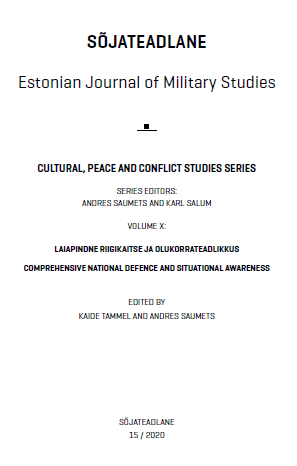ORGANISATSIOONIARHITEKTUUR JA VÕIMEPÕHINE PLANEERIMINE – TÕHUSA RIIGI TÖÖRIISTAD
ENTERPRISE ARCHITECTURE AND CAPABILITY-BASED PLANNING – TOOLS FOR AN EFFICIENT STATE
Author(s): Ivo PeetsSubject(s): Security and defense, Military policy, Methodology and research technology, Management and complex organizations
Published by: Kaitseväe Akadeemia (KVA)
Keywords: organization architecture; enterprise architecture; comprehensive national defence; capability-based planning; defence planning; NAFv4;
Summary/Abstract: The second law of thermodynamics, which in essence is universal, exists in the universe. A simple version of it explains that everything in the world moves involuntarily towards greater chaos and disorder, i.e. entropy keeps increasing. In order to reduce disorder or entropy it is essential to work not only to create material and intellectual values, but also to plan activities. We need to find and make use of the right “tools” to make the process of reducing the growth of entropy more effective. The present article elaborates on some of such tools from a vast variety. The research topic of the article emerged from the practical professional experience that cooperation between the state’s different areas of responsibility could be improved, as shortcomings in planning and common situational awareness became evident at the stage of drafting plans. This, in turn pointed to drawbacks in the accepted planning methods and also to possibilities to improve cross-sector exchange of information and cooperation by implementing uniform planning methods across sectors. Over some time, the defence domain has successfully implemented capability-based planning principles, which led to the question whether the method of capability-based planning could work for other domains as well and how this could assist in improving their cooperation. The study confirmed that capability-based planning methods could be applied together with the high-potential enterprise architecture method. The objective of the article was to confirm the above stated standpoints. The comparative analysis of planning methods, together with tracing possible faults that may emerge in their interaction, indicated that capability planning methods may be applied jointly with enterprise architecture methods. This kind of approach has the potential to improve the cooperation of state institutions and raise the general knowledge of situational awareness. To reach this objective, the mentioned methods were analysed in order to discover possible weaknesses and faults in their comparison and interaction, as well as their desired positive effects.
Journal: Sõjateadlane
- Issue Year: 2020
- Issue No: 15
- Page Range: 261-310
- Page Count: 50
- Language: Estonian

